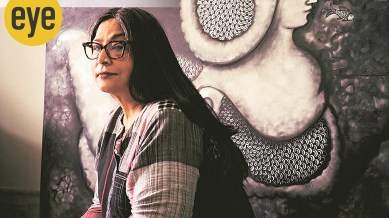Artist Jayasri Burman on using cowries in her recent works and painting Radhika Merchant Ambani’s lehenga
Artist Jayasri Burman on the mythological character she admires most, and how her painted lehenga for Radhika Merchant Ambani will be her first and last

Rooted in mythology, folklore, and the mythical, artist Jayasri Burman, 64, effortlessly navigates the intersection of tradition and modernity. In her ongoing solo at Art Alive Gallery in Delhi, she continues to explore her fascination with water bodies, bringing together elaborate paintings with mixed media works featuring cowries and shells.
You have painted shells and cowries previously, but this is the first time you’ve used them in mixed media works.
I am from Bengal and grew up admiring the ghats of the Ganga. Always attracted to water bodies, I fondly recall our family vacations to Digha and Puri, where I would sit with my grandfather on the beach, playing with sand, collecting shells and cowries. Even after washing them, the smell of the sea would never go away and that enticed me, making its way to the depths of my heart. I always endeavoured to capture these emotions in my art, and a few years ago it spontaneously started coming back to me — the sound of the sea, the eternal life cycle of cowries, their link with germination. The title of the show “The Whisper of the Water, The Song of Stars” refers to the song of life, reverberating from the riverbed that harbours the depths of our existence. The cowries have been collected during my travels and in these works they become part of my myths.
You often work on mythological themes but the stories are your own.
When I’m painting, I usually start with one figure and the rest keep coming to build a story. I enjoy listening to mythological stories. As a child, I heard several from my mother and at the jatras we attended. Even today, any new story intrigues me. These emerge in the artworks in myriad forms. For instance, a cousin recently told me how during the Samudra Manthan, a lot of cowries also emerged with the amrit (nectar). A symbol of growth and germination, the cowries also represent the body of a woman. So when I’m using them, I am also referencing the symbolism, it’s like a cosmic churn within me. The canvas is my performance stage, through which I am presenting a story and imparting a message.
You often paint strong female characters from mythology. Whom do you admire the most?
It would be Draupadi. To me, she is extremely powerful. Her twin brother Dhrishtadyumna and she were born from a fire sacrifice to fulfill Drupada’s desire for a son who could kill Drona. Her father wasn’t expecting her. Dark and beautiful, she always felt she was different from others and spent most of her time indoors, listening to lessons Krishna imparted to her brother. She wanted to marry Krishna but he refused, saying her destiny was to marry five men. Later, she was told couldn’t marry Karna either. She eventually married the Pandavas and was committed to all of them, but she loved Arjun most. Later, when they were heading to swarg, she questioned how it was unfair that her death came first. To me, she is Maha Saraswati, who had abundant gyan (knowledge), Maha Lakshmi who looked after the Pandavas, and Maha Kali, who raised her voice and asked for justice when she was disrobed by Duryodhana and Dushasana.
You studied at Kala Bhavan in Santiniketan and later went to Paris to learn printmaking. How did the two places influence you?
Santiniketan nurtures your mind and soul. It teaches you how to view things from your own unique perspective, and how no one can control your thoughts and creativity. I was fortunate to have teachers such as Sanat Kar and Ganesh Haloi.
When I first went to France in 1984, I was on the verge of crying. I had seen works by the Western masters in books but to see them in reality was a completely different experience. Inspired by how (Vincent) van Gogh used colours, I did many big oil paintings when I returned to India. I played a lot with colour, developing my own style and vocabulary.
The lehenga you painted for Radhika Merchant Ambani’s ‘Shubh Aashirwad’ ceremony last year received a lot of accolades. You worked on it for a month. If you could share the process.
I have known the Ambanis for many years and am really fond of the children (Isha, Anant and Akash) who had reached out to me more than 10 years ago for a big painting they wanted to gift their mother (Nita Ambani) for her birthday. I have met the family a couple of times and they have several of my paintings in their collection. When I was approached for the lehenga, I was initially reluctant as there was very little time, but after an interaction with Radhika I didn’t have the heart to say no. It couldn’t have been done on silk as that would have taken much longer, so the designers Abu Jani-Sandeep Khosla sent me an Italian canvas that could fall like cloth. I drew directly on the fabric and used tones of orange and pink, a colour I know the Ambanis like. It depicts togetherness and is a celebration of life with birds, animals, water, the wind and flowers in peace with humans. The musicians are playing instruments and celebrating the wedding. Painted as an art form, I have titled it Pranaya (marriage and togetherness, in Bengali). I have decided that I won’t paint another; some things should be unique.